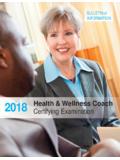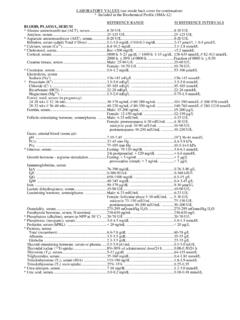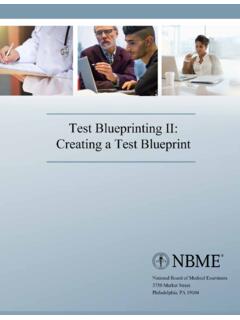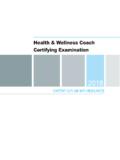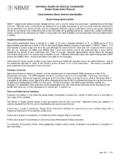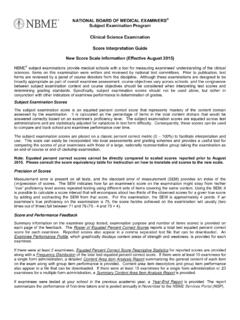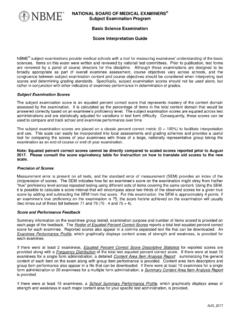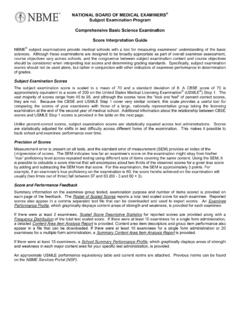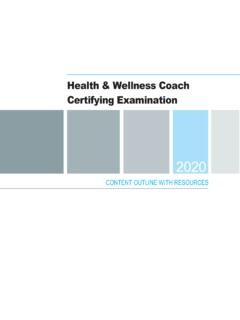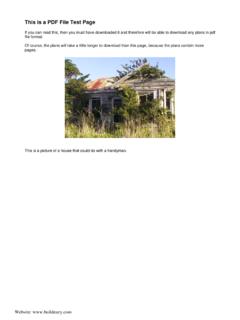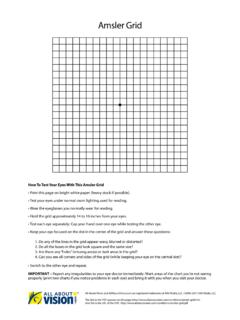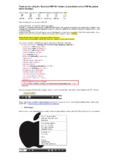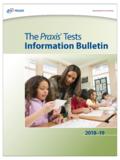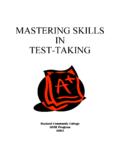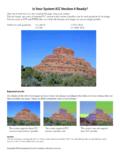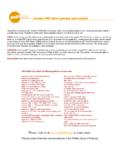Transcription of Constructing Written Test Questions For the Basic and ...
1 Constructing Written Test Questions For the Basic and Clinical Sciences Third Edition (Revised). National Board of Medical Examiners 3750 Market Street Philadelphia, PA 19104. Printed copies of this publication are not available from the National Board of Medical Examiners (NBME). Additional copies can be obtained by downloading the manual from the NBME's web site. Permission to copy and distribute this doc- ument is granted by the NBME provided that (1) the copyright and permission notices appear on all reproductions; (2) use of the document is for noncommercial, educational, and scientific purposes only; and (3) the document is not modified in any way. Any rights not expressly granted herein are reserved by the NBME. Copyright 1996, 1998 National Board of Medical Examiners (NBME ).
2 Copyright 2001, 2002 National Board of Medical Examiners (NBME ). All right reserved. Printed in the United States of America. Constructing Written Test Questions For the Basic and Clinical Sciences Third Edition (Revised). Contributing Authors Susan M. Case, PhD and David B. Swanson, PhD*. National Board of Medical Examiners 3750 Market Street Philadelphia, PA 19104. *Dr. Case was a Senior Evaluation Officer at the National Board of Medical Examiners when the first three editions of this manual were published; she is currently the Director of Testing at the National Conference of Bar Examiners. Dr. Swanson is the Deputy Vice President of Professional Services at the National Board of Medical Examiners. Table of Contents . Page Section I. Issues Regarding Format and Structure of Test Questions .
3 7. Chapter 1. Introduction .. 9. Assessment: An Important Component of Instruction .. 9. Issues of Sampling .. 10. Importance of Psychometric Considerations .. 11. Chapter 2. Multiple-Choice-Item Formats .. 13. True/False vs One-Best-Answer Questions .. 13. The True/False Family .. 14. The One-Best-Answer Family .. 16. The Bottom Line on Item Formats .. 18. Chapter 3. Technical Item Flaws .. 19. Issues Related to Testwiseness .. 19. Issues Related to Irrelevant Difficulty .. 22. Summary of Technical Item Flaws .. 26. Use of Imprecise Terms in Examination Questions .. 27. Section II. Writing One-Best-Answer Questions for the Basic and Clinical Sciences .. 31. The Basic Rules for One-Best-Answer Items .. 33. Chapter 4. Item Content: Testing Application of Basic Science Knowledge.
4 35. Item Content for the Basic Sciences .. 35. Item Templates .. 38. Additional Templates .. 39. Types of Questions and Sample Lead-ins and Option Lists .. 40. Writing the Options: Altering Item Difficulty .. 41. Item Shape .. 42. Problem-Based Learning and Use of Case Clusters .. 43. Sample Items for the Basic Sciences .. 47. Chapter 5. Item Content: Testing Application of Clinical Science Knowledge .. 51. Methods for Assessment .. 51. General Issues Regarding What to Test .. 52. Testing Recall of Isolated Facts or Application of Knowledge .. 53. Writing One-Best-Answer Items .. 56. Fine Points on Item Stems .. 57. Verbosity, Window Dressing, and Red Herrings: Do They Make a Better Test Item? .. 58. Writing Items Related to Physician Tasks .. 61. Writing Items on Difficult Topics.
5 66. Section III. Extended-Matching Items .. 69. Chapter 6. Extended-Matching (R-Type) Items .. 71. Avoiding Flaws When You Write Extended-Matching Items for Your Own Examination .. 72. Sample Lead-ins and Topics for Option Lists .. 74. More on Options for R-Sets .. 75. Writing the Item Stems .. 76. Sample Good and Bad Item Stems Using the Same Option List .. 77. Overview of the Steps for Writing Extended-Matching Items .. 81. Sample Extended-Matching Sets .. 82. Steps for Organizing a Group to Write Clinical R-sets .. 90. Form for Writing R-Sets .. 93. Sample SPSSX Code to Score Multiple-Choice tests Including Extended-Matching Items .. 94. Comparison of Items in Five-Option and Extended-Matching Format .. 96. A's to R's and Back Again .. 97. Chapter 7. Pick N Items: An Extension of the Extended-Matching Format.
6 99. Section IV. Additional Issues .. 105. Chapter 8. Interpretation of Item Analysis Results .. 107. Chapter 9. Establishing a Pass/Fail Standard .. 111. Definitions and Basic Principles .. 111. Two Standard-Setting Methods Based on Judgements about Items .. 112. Relative/Absolute Compromise Standards: The Hofstee Method .. 114. Chapter 10. Miscellaneous Thoughts on Topics Related to Testing .. 115. Appendix A. The Graveyard of NBME Item Formats .. 117. Appendix B. Sample Item-Writing Templates, Items, Lead-Ins, and Option Lists For the Basic and Clinical Sciences ..129. Preface to Third Edition . This manual was Written to help faculty members improve the quality of the multiple-choice Questions Written for their exam- inations. The manual provides an overview of item formats, concentrating on the traditional one-best-answer and matching formats.
7 It reviews issues related to technical item flaws and issues related to item content. The manual also provides Basic information to help faculty review statistical indices of item quality after test administration. An overview of standard-set- ting techniques is also provided. Issues related to exam blueprinting are not addressed in any detail. We have focused almost exclusively on the item level, leaving exam level planning for another manuscript. We anticipate that this manual will be useful primarily by faculty who are teaching medical students in Basic science cours- es and clinical clerkships. The examples focus on undergraduate medical education, though the general approach to item writing may be useful for assessing examinees at other levels. This manual reflects lessons that we have learned in developing items and tests over the past 20 years.
8 During this period, we have reviewed (quite literally) tens of thousands of multiple-choice Questions and have conducted item-writing workshops for thousands of item writers preparing USMLE, NBME, and specialty board examinations as well as faculty at more than 60. medical schools developing test Questions for their own examinations. Each workshop attendee has helped us to frame our thoughts regarding how to write better quality test Questions , and, over the years, we have become better able (we believe) to articulate the why's and wherefore's. We hope this manual helps to communicate these thoughts. Susan M. Case, PhD. David B. Swanson, PhD. January 1998. Section I. Issues Regarding Format and Structure of Test Questions . This section reviews structural issues important for the construction of high-quality test Questions .
9 The following section will review issues related to item content. Chapter 1. Introduction . Assessment: An Important Component of Instruction Assessment is a critical component of instruction; properly used, it can aid in accomplishing key curricular goals. The impact of decisions regarding how and when to evaluate the knowledge and performance of your students cannot be overestimated. A primary purpose of testing is to communicate what you view as important. tests are a powerful motivator, and students will learn what they believe you value. Assessment also helps to fill instructional gaps by encouraging students to read broad- ly on their own and to participate broadly as educational opportunities are available. This outcome of testing is especially important in the clerkships, where the curriculum may vary from student to student, depending on factors such as the clinical setting and the random flow of patients.
10 This outcome may also be important in some Basic -science settings (eg, problem- based learning), where the educational experiences may vary from student to student. Because tests have such a powerful influence on student learning, it is important to develop tests that will further your edu- cational goals. Introduction of a hands-on clinical skills test drives students out of the library into the clinic, where they may seek help with their physical-exam skills; introduction of a test assessing only recall of isolated facts, on the other hand, dri- ves them to cram course review books. This manual focuses on how to write high-quality, multiple-choice Questions that assess skill in interpreting data and making decisions, which we believe are important components of clinical skills.
